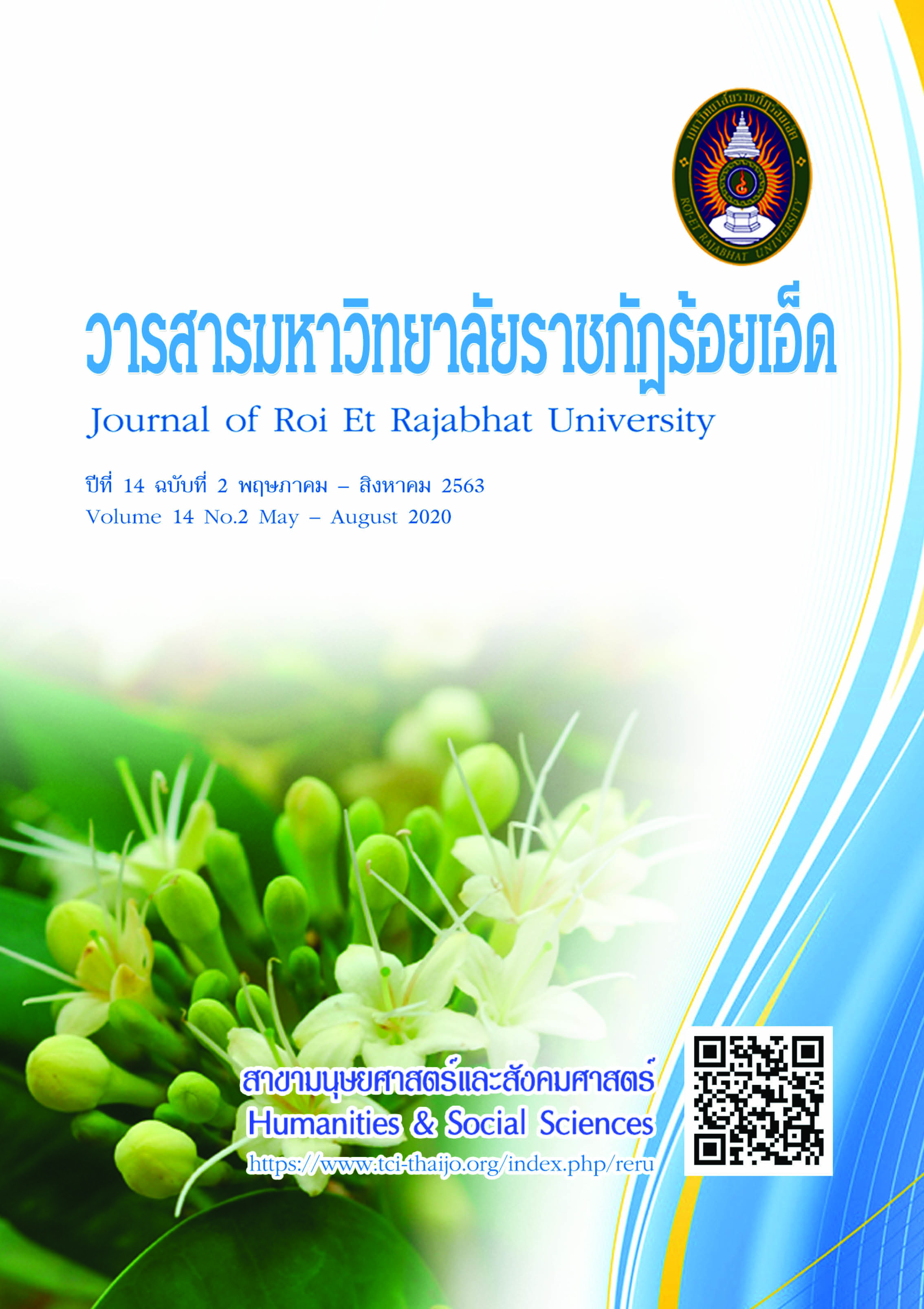การพัฒนารูปแบบการเรียนการสอนเพื่อส่งเสริมความสามารถในการแก้ปัญหาทางคณิตศาสตร์ สำหรับนักเรียนชั้นมัธยมศึกษาปีที่ 3
คำสำคัญ:
รูปแบบการเรียนการสอน, ความสามารถในการแก้ปัญหาทางคณิตศาสตร์, การแก้ปัญหาทางคณิตศาสตร์บทคัดย่อ
การวิจัยครั้งนี้มีวัตถุประสงค์เพื่อ 1) ศึกษาข้อมูลพื้นฐานและความต้องการในการพัฒนารูปแบบการเรียนการสอน
2) พัฒนารูปแบบการเรียนการสอน 3) ทดลองใช้และศึกษาประสิทธิผลของรูปแบบการเรียนการสอน โดยเปรียบเทียบผลสัมฤทธิ์ทางการเรียนคณิตศาสตร์ก่อนและหลังการใช้รูปแบบการเรียนการสอน และเปรียบเทียบความสามารถในการแก้ปัญหาทางคณิตศาสตร์ก่อนและหลังการใช้รูปแบบการเรียนการสอน และ 4) ประเมินและปรับปรุงรูปแบบการเรียนการสอน
จากการศึกษาความคิดเห็นของนักเรียนที่มีต่อการใช้รูปแบบการเรียนการสอนโดยใช้แบบแผนดำเนินการวิจัยและพัฒนา (Research and Development) กลุ่มตัวอย่างเป็นนักเรียนชั้นมัธยมศึกษาปีที่ 3 ปีการศึกษา 2560 โรงเรียนจุมจังพลังราษฎร์ เครื่องมือที่ใช้ในการวิจัย ได้แก่ รูปแบบการเรียนการสอน คู่มือการใช้รูปแบบการเรียนการสอน แผนการจัดการเรียนการสอน แบบทดสอบวัดผลสัมฤทธิ์ทางการเรียน แบบทดสอบวัดความสามารถในการแก้ปัญหาทางคณิตศาสตร์ แบบสอบถาม
ความคิดเห็นของนักเรียนที่มีต่อการใช้รูปแบบการเรียนการสอน วิเคราะห์ข้อมูลโดยการหาค่าเฉลี่ย ส่วนเบี่ยงเบนมาตรฐาน
ค่าทีแบบไม่อิสระและการวิเคราะห์เนื้อหา ผลการวิจัยพบว่า รูปแบบการเรียนการสอนที่พัฒนาขึ้นมีองค์ประกอบ ได้แก่
1) หลักการ 2) วัตถุประสงค์ 3) กระบวนการเรียนการสอน 4) หลักการตอบสนอง 5) ระบบสังคม 6) สิ่งสนับสนุน 7) สาระความรู้ และ 8) สิ่งที่ส่งเสริมการเรียนรู้ กระบวนการจัดการเรียนการสอนมี 7 ขั้นตอน ได้แก่ 1) ขั้นนำ 2) ขั้นเผชิญสถานการณ์ปัญหา 3) ขั้นระดมสมอง 4) ขั้นตรวจสอบความรู้ 5) ขั้นสรุป 6) ขั้นฝึกทักษะ 7) ขั้นประเมินผล ผลสัมฤทธิ์ทางการเรียน
และความสามารถในการแก้ปัญหาทางคณิตศาสตร์ของนักเรียนหลังเรียนสูงกว่าก่อนเรียนอย่างมีนัยสำคัญทางสถิติที่ระดับ .05 นักเรียนเห็นด้วยในการใช้รูปแบบการเรียนการสอนในระดับมากที่สุด
เอกสารอ้างอิง
กมลฉัตร กล่อมอิ่ม. (2557). การพัฒนารูปแบบการเรียนรู้ตามแนวทฤษฎีคอนสตรัคติวิสต์ด้วยการช่วยเสริมศักยภาพเพื่อส่งเสริม
ทักษะกระบวนการทางคณิตศาสตร์ด้านการแก้ปัญหา สำหรับนักเรียนชั้นมัธยมศึกษาปีที่ 1. วารสารศึกษาศาสตร์
มหาวิทยาลัยนเรศวร, 16(2), 129–139.
กระทรวงศึกษาธิการ. (2553). พระราชบัญญัติการศึกษาแห่งชาติ พ.ศ. 2542 และที่แก้ไขเพิ่มเติม (ฉบับที่ 2) พ.ศ. 2545
และพระราชบัญญัติการศึกษาภาคบังคับ พ.ศ. 2553. กรุงเทพฯ: อักษรไทย.
กระทรวงศึกษาธิการ. (2551). หลักสูตรแกนกลางการศึกษาขั้นพื้นฐาน พุทธศักราช 2551. กรุงเทพฯ: โรงพิมพ์ชุมนุมสหกรณ์
การเกษตรแห่งประเทศไทย.
กาญจนา คุณารักษ์. (2552). การออกแบบการเรียนการสอน (พิมพ์ครั้งที่ 3). นครปฐม: โรงพิมพ์มหาวิทยาลัยศิลปากร.
ทิศนา แขมมณี. (2552). รูปแบบการเรียนการสอนทางเลือกที่หลากหลาย. กรุงเทพฯ: โรงพิมพ์จุฬาลงกรณ์มหาวิทยาลัย.
ทิศนา แขมมณี. (2554). ศาสตร์การสอน:องค์ความรู้เพื่อการจัดกระบวนการเรียนรู้ที่มีประสิทธิภาพ.กรุงเทพฯ: โรงพิมพ์
จุฬาลงกรณ์มหาวิทยาลัย.
ปุณณัฏฐ์ณิชา สืบสายลา. (2556). การพัฒนากิจกรรมการเรียนรู้คณิตศาสตร์ โดยใช้รูปแบบการจัดการเรียนรู้ ตามแนวคิด
คอนสตรัคติวิสต์ที่เน้นทักษะการคิดวิเคราะห์ เรื่องอัตราส่วนและร้อยละ ระดับมัธยมศึกษาตอนต้น
สังกัดศูนย์การศึกษานอกระบบและการศึกษาตามอัธยาศัย. วิทยานิพนธ์ ศึกษาศาสตรมหาบัณฑิต
สาขาวิชาหลักสูตรและการสอน. ขอนแก่น: มหาวิทยาลัยขอนแก่น.
พรทิพา เมืองโคตร. (2559). ความสามารถในการแก้ปัญหาทางคณิตศาสตร์โดยการจัดการเรียนรู้โดยใช้ปัญหาเป็นฐาน ของนักเรียน
ชั้นมัธยมศึกษาปีที่ 3 เรื่องพื้นที่ผิวและปริมาตร. วิทยานิพนธ์ วิทยาศาสตรหาบัณฑิต สาขาวิชาคณิตศาสตร์ศึกษา.
มหาสารคาม: มหาวิทยาลัยมหาสารคาม.
เพชราภรณ์ หอมสร้อย. (2556). การพัฒนากิจกรรมการเรียนรู้โดยใช้ปัญหาเป็นหลัก เรื่องสิ่งมีชีวิตกับสิ่งแวดล้อม กลุ่มสาระ
การเรียนรู้วิทยาศาสตร์ ชั้นประถมศึกษาปีที่ 6. วิทยานิพนธ์ ครุศาสตรมหาบัณฑิต สาขาวิชาหลักสูตรและการสอน.
สกลนคร: มหาวิทยาลัยราชภัฏสกลนคร.
มัณฑรา ธรรมบุศย์. (2545). การพัฒนาคุณภาพการเรียนรู้โดยใช้ PBL (Problem-Based Learning). วารสารวิชาการ, 5(2), 11-17.
โรงเรียนจุมจังพลังราษฎร์. (2559). รายงานการประเมินตนเอง (SELF ASSESSMENT REPORT : SAR). กาฬสินธู์: โรงเรียนจุมจังพลังราษฎร์.
วัชรา เล่าเรียนดี. (2554). การนิเทศการสอน สาขาวิชาหลักสูตรและการนิเทศ. นครปฐม: โรงพิมพ์มหาวิทยาลัยศิลปากร
วิทยาเขตพระราชวังสนามจันทร์.
วิไล โพธิ์ชื่น. (2555). การพัฒนาความสามารถในการคิดแก้ปัญหาคณิตศาสตร์ของนักเรียนชั้นมัธยมศึกษาปีที่ 3 ที่จัดการเรียนรู้
โดยใช้ปัญหาเป็นฐาน. วิทยานิพนธ์ ศึกษาศาสตรมหาบัณฑิต สาขาวิชาหลักสูตรและการนิเทศ. นครปฐม:
มหาวิทยาลัยศิลปากร.
สถาบันส่งเสริมการสอนวิทยาศาสตร์และเทคโนโลยี. (2555). ทักษะและกระบวนการทางคณิตศาสตร์ (พิมพ์ครั้งที่ 3). กรุงเทพฯ: 3-คิวมีเดีย.
สิริพรรณ สีดาบุญมา. (2556). การพัฒนากิจกรรมการเรียนรู้คณิตศาสตร์ โดยใช้รูปแบบการจัดการเรียนรู้ตามแนวคิดคอนสตรัคติวิสต์
ที่เน้นทักษะการคิดวิเคราะห์ เรื่อง การบวก การลบ การคูณ และการหารเศษส่วน ชั้นประถมศึกษาปีที่ 5.
วิทยานิพนธ์ ศึกษาศาสตรมหาบัณฑิต สาขาวิชาหลักสูตรและการสอน. ขอนแก่น: มหาวิทยาลัยขอนแก่น.
อรุณี โสภา. (2556). การพัฒนากิจกรรมการเรียนรู้คณิตศาสตร์ โดยใช้รูปแบบการจัดการเรียนรู้ตามแนวคิดคอนสตรัคติวิสต์ที่เน้น
ทักษะการคิดวิเคราะห์ เรื่องความน่าจะเป็น ชั้นมัธยมศึกษาปีที่ 3. วิทยานิพนธ์ ศึกษาศาสตรมหาบัณฑิต
สาขาวิชาหลักสูตรและการสอน. ขอนแก่น: มหาวิทยาลัยขอนแก่น.
อัมพร ม้าคนอง. (2554). ทักษะและกระบวนการทางคณิตศาสตร์ (พิมพ์ครั้งที่ 2). กรุงเทพฯ: โรงพิมพ์แห่งจุฬาลงกรณ์มหาวิทยาลัย.
Dick, W., Carey L. and Carey, J.O. (2005). The Systematic Desige of Instruction (5th ed.). New York: Addison-
Wesley, Longman.
Joyce, B. and Weil, M. (2004). Models of teaching (3rd ed.). Englewook Cliffs, New Jersry: Prentice-Hill
International Editions.
Joyce, B., and Weil, M. (2009). Modejs of teaching (8th ed.). Boston, Ma. : Peareon.
Kemp, J. E. (1985). The Instructional Design Process. New York: Harper & Row Publishers.
National Council of Teachers of Mathematics (NCTM). (2010). Why is teaching with Broblemm solving
importance to student learning? Problem solving research brife. Retrieved April 25, 2016,
from: http://www.nctm.org/uploadedFiles/Research_and_Advocacy/research_
brief_and clips/Research_brief_14_-_Problem_Solving.pdf?%20Target
ดาวน์โหลด
เผยแพร่แล้ว
รูปแบบการอ้างอิง
ฉบับ
ประเภทบทความ
สัญญาอนุญาต
บทความที่ได้รับการตีพิมพ์เป็นลิขสิทธิ์ของวารสารมหาวิทยาลัยราชภัฎร้อยเอ็ด
ข้อความที่ปรากฏในบทความแต่ละเรื่องในวารสารวิชาการเล่มนี้เป็นความคิดเห็นส่วนตัวของผู้เขียนแต่ละท่านไม่เกี่ยวข้องกับมหาวิทยาลัยราชภัฎร้อยเอ็ด และคณาจารย์ท่านอื่นๆในมหาวิทยาลัยฯ แต่อย่างใด ความรับผิดชอบองค์ประกอบทั้งหมดของบทความแต่ละเรื่องเป็นของผู้เขียนแต่ละท่าน หากมีความผิดพลาดใดๆ ผู้เขียนแต่ละท่านจะรับผิดชอบบทความของตนเองแต่ผู้เดียว





